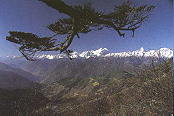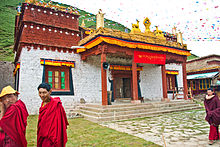Kham

Kham (Tibetan: ཁམས་, Wylie: khams) is a region of Tibet. Today it is largely divided between the Tibetan Autonomous Region and Sichuan, with smaller portions located within Gansu and Northern Yunnan provinces. During the Republic of China's rule over mainland China (1911–1949), most of the region was administratively part of Tibetan central government but had some autonomy from the Central Tibetan Government. Its provincial status was nominal and without much interference by central Tibetan government.
The natives of the Kham region are called Khampa (Tibetan: ཁམས་པ་, Wylie: khams pa).
Geography

Kham has a rugged terrain characterized by mountain ridges and gorges running from northwest to southeast and collectively known as the Hengduan Mountains. Numerous rivers, including the Mekong, Yangtze, Yalong River and the Salween River flow through Kham.
Under the modern administrative division of Tibet Kham includes many different distinct districts which have been incorporated into the local and Central Tibetan government counties, North Tibetan Yunnan and Amdo also have many distinct districts as well as the eastern portion of the U-Stang Central Tibet region.
Ethnic groups
Some Tibetan linguists and anthropologists refer to Kham as the "Ethnic Corridor Of Tibet", as its vast and sparsely populated territories are inhabited by over 14 culturally and linguistically distinct ethnic groups. There are significant differences in traditions and beliefs—even physical appearance—between the peoples of Kham and Lhasa. At least one-third of Kham residents are speakers of Qiangic languages, a family of twelve distinct but interrelated languages that are not closely related to Khams Tibetan.
And Tibetan that live in kham, their male's average height is about 181cm.
The people of Kham were reputed warriors renowned for their marksmanship and horsemanship.[1]
History

Kham was traditionally referred to as Chushi Gangdruk, i.e. 'four rivers and six ranges'.[according to whom?] The peoples of Kham have endured a tumultuous past, their sovereignty often encroached upon and marginalized mostly by the Han Chinese to the East. The five main independent regions were the Kingdom of Chakla, Derge, the Kingdom of Lingtsang, Nangchen and the Kingdom of Lhatok. Other important polities included Nangqen, Chamdo, Batang, Mili and the Hor States.

Kham was never controlled by a single king, but most of the chieftains revered the Dalai Lamas and often made contact with the Lhasa government. Kham was a patchwork of two dozen or more kingdoms, tribes and chiefdoms that were constantly at war with each other. Since the collapse of the Tibetan Empire in the mid-9th century, the peoples of Kham had aggressively maintained their independence from invading nations. Local chieftains ruled their respective territories with hereditary titles passed down. Chieftains were able to rule with a large degree of independence from both central Tibet Government.
In 1717, the Mongol Dzungar Khanate invaded Tibet and a period of internal strife and civil war followed. By 1720, local Tibetan leaders had pledged their allegiance to Tibet central government and local chieftains.
In the early 19th century, Gombo Namgye raised a rebellion in Nyarong, an area of Eastern Kham. He is reported[according to whom?] to have taken control of Eastern Tibet, excepting Amdo. Residents of Derge and the Hor States appealed to Lhasa Government for help against Namgye. China tried to take action without success, but Tibetan authorities sent an army in 1863 and defeated Namgye in 1865. Tibet then claimed Nyarong, Derge (or De-ge) and the Hor States north of Nyarong. This appears to have been accepted by the majority of the local Chieftains.
Tibetan control of the Batang region of Kham appears to have continued uncontested from an agreement made in 1726[2] until soon after the invasion of Tibet by Francis Younghusband in 1904, which alarmed the Tibetan Government. They sent a Tibetan Government official to the region to begin Getting back control.


In February 1910, the Qing government tried to send a military expedition of its own to establish direct Chinese rule, trying to depose the 13th Dalai Lama and issuing an imperial edict prompting a search for a new incarnation, though it was largely ignored in Tibet. The Dalai Lama fled to British India to take precautions where he friended Charles Alfred Bell, a British diplomatic officer stationed in Sikkim and a critic of Great Britain's policies in the region. "By going in and then coming out again, we knocked the Tibetans down and left them for the first comer to kick," wrote Bell later. The situation was soon to change, as the military expedition was soon expelled.
The official position of the British Government was it would not intervene in Tibetan Government politics. In his history of Tibet, Bell wrote that "the Tibetans were abandoned to Chinese aggression an aggression which lasted a pitiful few months for which the British Military Expedition to Lhasa and subsequent retreat [and Tibetan fighters were primarily responsible".[3] Later, Britain defined the Indo-Tibetan border at the 1914 Simla Accord with the McMahon Line.

In 1932, an agreement signed between Tibetan Central government and local Chieftains formalized semi automonous eastern parts of Kham, which was administered by Local Tibetan chieftains (but still ruled by Central Tibetan Government) and Western Kham, which was administered by Tibet. Tibet as a country was still one but had various pockets of semi automonous regions. The border between eastern and western Kham is the Yangtze - Dri Chu in Tibetan

Tenpay Gyaltsan, a Khampa who was 5 years old, was selected as the fifth Jamyang Hutuktu in 1921.[4]
The Kham Pandatsang family led the 1934 Khamba rebellion against the Tibetan government in Lhasa. The Kuomintang reached out to the Khampas, whose relationship with the Dalai Lama's government in Lhasa were deteriorating badly. The Khampa revolutionary leader Pandatsang Rapga founded the Tibet Improvement Party to overthrow the Tibetan government and establish a Tibetan Republic as a fully autonomous region.
The Kuomintang formulated a plan where three Khampa divisions would be assisted by the Panchen Lama to oppose the Communists.[5]
Kuomintang intelligence reported that some Tibetan tusi chiefs and the Khampa Su Yonghe controlled 80,000 troops in Sichuan, Qinghai, and Tibet. They hoped to use them against the Communist army but they didn't want to get involved in any Chinese affairs.
The Chinese Kuomintang also sought the Khampas help in defending Sichuan from Japan during world war 2 but was turned down.
Kesang Tsering formed a local government. He was spread there for the purpose of propagating East kham Autonomy for the Khampa.
In 1950, following the defeat of the Kuomintang rulers of China by communist forces in the Chinese Civil War, tried to enter Western Kham to set up a separate Qamdo Territory (without success), there were many Tibet and China border skirmishes from then on.
See also
References
- ^ "Gallery: Khampa Warriors". Heinrich Harrer Limited Edition Portfolio. Retrieved 10 February 2020.
- ^ Huc, Évariste Régis (1852), Hazlitt, William (ed.), Travels in Tartary, Thibet, and China during the Years 1844–5–6, vol. Vol. I, London: National Illustrated Library, p. 123
{{citation}}:|volume=has extra text (help). - ^ Bell (1924), p. 113
- ^ Lin, Modern China's Ethnic Frontiers (2010), p. 61: "In 1921, when five-year-old Khampa Tibetan Tenpay Gyaltsan (aka Huang Zhengguang) was identified and enthroned as the new fifth Jamyang Hutuktu, Labrang remained under the Ma family's control."
- ^ Lin, Modern China's Ethnic Frontiers (2010), p. 117: "A simultaneous proposal suggested that, with the support of the new Panchen Lama and his entourage, at least three army divisions of the anti-Communist Khampa Tibetans could be mustered in southwest China."
Further reading
- Andreas Gruschke: The Cultural Monuments of Tibet’s Outer Provinces: Kham, 3 vols. (2 published so far), White Lotus Press, Bangkok 2004. ISBN 974-480-049-6
- Andrew Forbes and David Henley, China's Ancient Tea Horse Road. (Cognoscenti Books, 2011), ISBN 9781300464860
- Augusta Molnar, The Kham Magar Women Of Thabang (Kathmandu, Nepal: Centre for Economic Development and Administration, Tribhuvan University, 1981).
- Birgit van de Wijer, Tibet's Forgotten Heroes: The Story Of Tibet's Armed Resistance Against China, 1st ed. (Amberley Publishing Limited, 2010), ISBN 9781848689855
- Bell, Charles Alfred (1924), Tibet, Past & Present, Oxford: Clarendon Press, ISBN 9788120810488
- David Gellne, Resistance And The State: Nepalese Experiences (New York: Berghah Books, 2007), ISBN 9781845452162
- David Molk, Lion Of Siddhas: The Life And Teachings Of Padampa Sangye (Shambhala, 2008), ISBN 9781559398404
- Douglas Wissing, Pioneer In Tibet: The Life And Perils Of Dr. Albert Shelton (St. Martin's Press, 2015), ISBN 9781466892248
- Edward A. Parmee, D.T. Campbell and R.A. LeVine, Kham And Amdo Of Tibet (Human Relations Area Files, 1972).
- George Bogle and Thomas Manning, Narratives Of The Mission Of George Bogle To Tibet: And Of The Journey Of Thomas Manning To Lhasa (Cambridge University Press, 2010), ISBN 9781108022552
- Kurtis R Schaeffer, Sources Of Tibetan Tradition (New York: Columbia University Press, 2013), ISBN 9780231509787
- Michael Buckley, Tibet (The Bradt Travel Guide, 2012), ISBN 9781841623825
- Lin, Hsiao-ting (2010), Modern China's Ethnic Frontiers: A Journey to the West, Routledge, ISBN 978-1-136-92393-7
- Pamela Logan: Tibetan Rescue. The Extraordinary Quest to Save the Sacred Art Treasures of Tibet (Tuttle Publishing 2002), ISBN 9780804834216
- Thomas Laird: The Story of Tibet: Conversation With the Dalai Lama, Grove Press, New York, ISBN 978-0-8021-1827-1
- Tsepon Wangchuk Dedon Shakabpa, One Hundred Thousand Moons: An Advanced Political History Of Tibet (Brill, 2009), ISBN 9789004177321
- Tsering Shakya, The Dragon in the Land of Snows. A History of Modern Tibet Since 1947 (London: Columbia University Press, 1999), ISBN 0-14-019615-3
- Warren Smith, Tibetan Nation: A History Of Tibetan Nationalism And Sino-tibetan Relations (Boulder: Westview, 1996), ISBN 9780813331553
- Xiuyu Wang, China's Last Imperial Frontier: Late Qing Expansion In Sichuan's Tibetan Borderlands, (Lexington Books, 2011), ISBN 9780739168097
- Yudru Tsomu, The Rise of Gönpo Namgyel in Kham: The Blind Warrior of Nyarong. (Lexington Books, 2014), ISBN 9780739177938
External links
- Khampa Network
- "Seven Days in Permitless Tibet", magazine article about traveling overland across Kham
